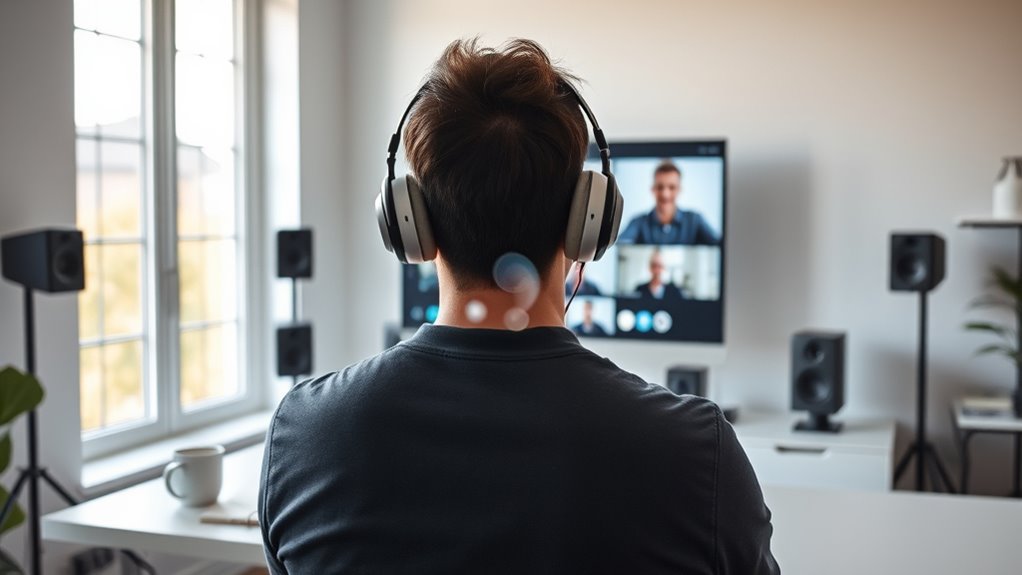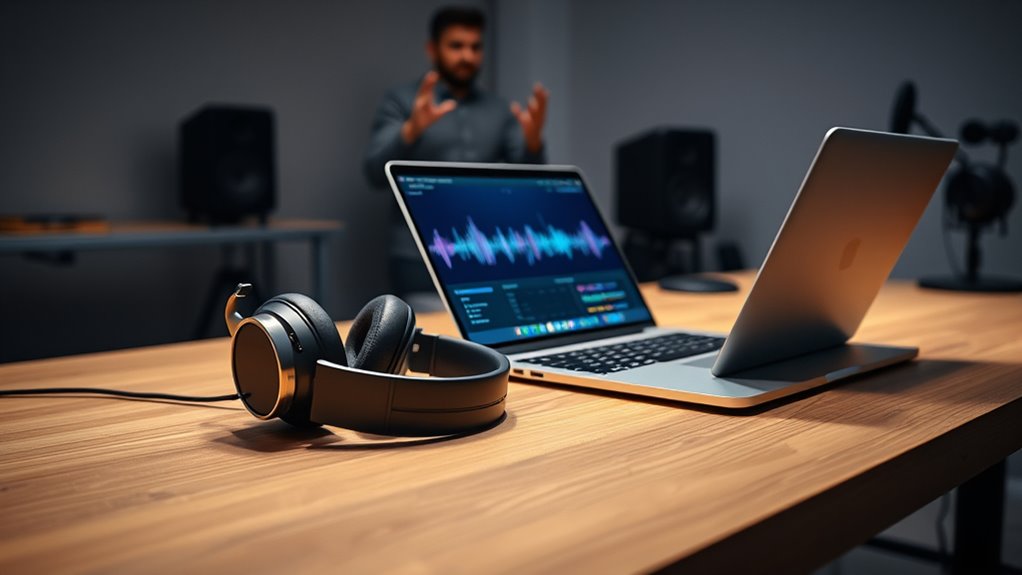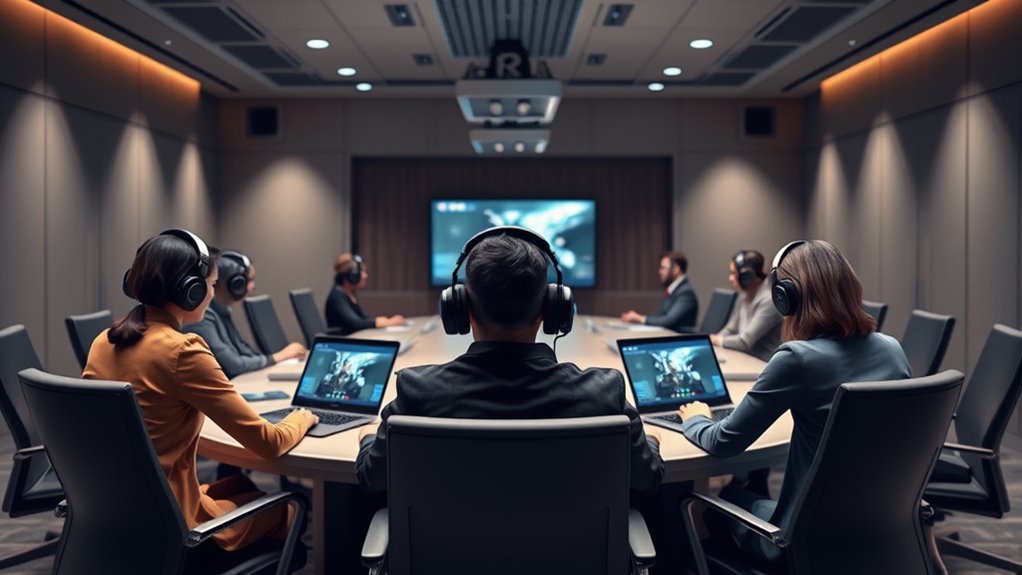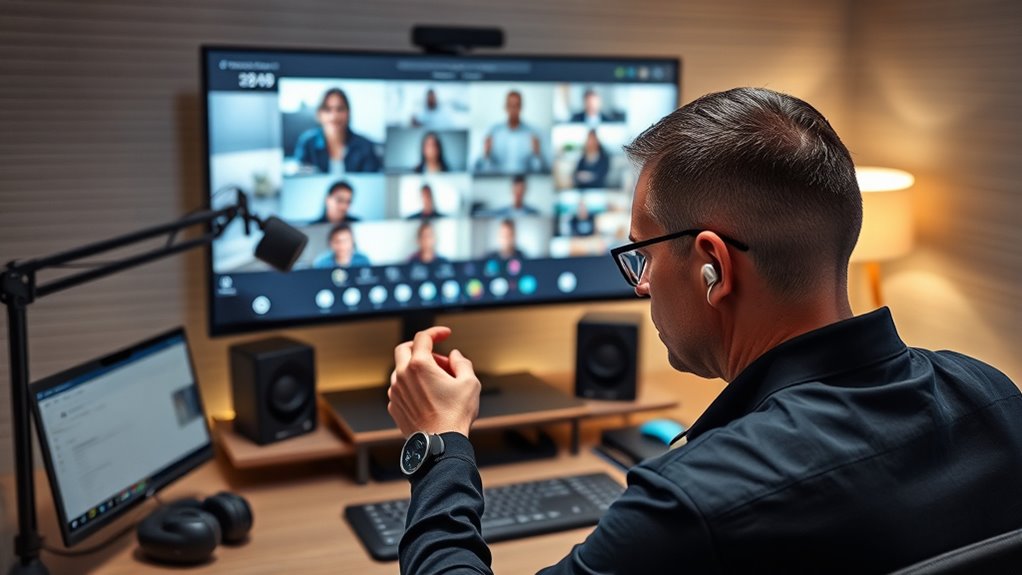To set up spatial audio for remote collaboration, make certain your hardware supports features like Dolby Atmos or Windows Sonic, and use compatible headphones or speakers. Configure your platform’s settings, test your setup beforehand, and position your audio devices correctly to create a natural sound environment. Practice good etiquette by respecting virtual boundaries, speaking clearly, and using mute wisely. Continuing with these tips will help you optimize your immersive experience and improve team communication.
Key Takeaways
- Ensure your hardware supports spatial audio features and is properly calibrated for accurate sound positioning.
- Enable spatial audio settings within your collaboration platform and test before meetings.
- Position speakers or headphones at ear level and minimize reflective surfaces for optimal sound clarity.
- Maintain balanced audio levels, use mute strategically, and respect virtual boundaries for natural interaction.
- Troubleshoot connectivity, update drivers, and use quality equipment to sustain immersive and clear remote collaboration.
Understanding Spatial Audio and Its Benefits

Spatial audio creates a more immersive sound environment by simulating how we naturally perceive sound direction and distance. When you use spatial audio, sounds come from specific locations, making it easier to distinguish voices and background noises. This technology helps you feel more connected during remote meetings, reducing confusion and miscommunication. It mimics real-world hearing, so you can identify who’s speaking and where they’re positioned, even if you’re on a crowded call. Spatial audio also minimizes overlapping voices, creating clearer conversations. This enhances focus and engagement, making collaboration feel more natural. Additionally, as AI security continues to evolve, integrating spatial audio can help improve the detection of anomalies or unauthorized access during virtual meetings, further enhancing safety and trust. Overall, it transforms digital communication by providing a richer, more realistic audio experience that closely resembles in-person interactions.
Choosing the Right Hardware and Software

Choosing the right hardware and software is vital for a seamless spatial audio experience. You need compatible devices that support spatial sound features and effective software solutions that facilitate easy setup and clear audio. Evaluating your options carefully helps guarantee your remote collaboration is both immersive and dependable. Additionally, considering Kia Tuning options can inspire innovative ideas for customizing your audio setup to better suit your preferences and environment.
Compatible Hardware Options
Selecting the right hardware and software is essential to experience high-quality spatial audio during remote collaboration. Your setup should include compatible headphones or speakers that support spatial audio, along with a computer or device capable of handling the technology. Look for hardware with built-in 3D audio features or support for spatial sound formats like Dolby Atmos or Windows Sonic. Ensuring your system is optimized for Honda Tuning features can also enhance overall audio performance.
Effective Software Solutions
To achieve high-quality spatial audio during remote collaboration, you need software that seamlessly integrates with your hardware setup. Look for platforms that support your chosen devices and provide reliable, low-latency audio processing. Popular options like SpatialChat, Discord with spatial audio plugins, or specialized tools like Oculus Venues offer immersive experiences and easy-to-use interfaces. Guarantee the software supports multi-user environments and offers features like directional sound control, voice isolation, and adjustable spatial parameters. Compatibility across different operating systems is also vital if your team uses diverse devices. Before committing, test the software’s performance with your hardware to confirm it delivers clear, synchronized audio. Ensuring the high refresh rates of your hardware components contribute to a more seamless and realistic spatial audio experience. Choosing the right software ensures your spatial audio experience is smooth, natural, and effective for remote collaboration.
Setting Up Your Space for Optimal Experience

Creating an ideal environment for spatial audio begins with optimizing your physical space. Start by choosing a quiet, clutter-free room to prevent background noise and distractions. Use soft furnishings like rugs, curtains, and cushions to absorb sound reflections and reduce echo. Position your speakers or headphones at ear level and avoid placing reflective surfaces behind or beside your audio devices. To visualize, consider this setup:
| Element | Recommended Placement | Purpose |
|---|---|---|
| Microphone | Near your mouth, unobstructed | Clear voice capture |
| Speakers/Headphones | Equidistant from your ears | Balanced audio experience |
| Furniture | Against walls, away from speakers | Minimize sound reflections |
| Soft furnishings | Strategically placed around room | Reduce echo and noise |
| Room lighting | Soft, indirect lighting | Maintain focus and comfort |
This setup ensures clean, immersive spatial audio for remote collaboration. Additionally, proper acoustic treatment enhances overall audio quality by further reducing unwanted sound reflections.
Configuring Spatial Audio on Common Platforms

Once your physical setup is optimized, the next step is to configure spatial audio on the platforms you use for remote collaboration. First, verify your device’s audio drivers and system settings support spatial audio features. For platforms like Zoom or Microsoft Teams, check their audio settings for spatial audio options and enable them if available. Some platforms require you to install specific plugins or updates—confirm you have the latest version. For apps like Discord or Slack, explore third-party tools that add spatial audio capabilities. Always test your setup before a meeting to confirm spatial positioning works correctly. Keep in mind that not all platforms support spatial audio natively, so understanding their specific configuration options ensures you get the most immersive experience. Additionally, retail hours today can be helpful to plan your setup time around store availability if you need supplies.
Best Practices for Using Spatial Audio During Meetings

To make the most of spatial audio in meetings, you should keep audio levels clear and balanced so everyone can hear each other comfortably. Respect personal space by positioning voices naturally, which helps avoid confusion or overlap. Also, use mute strategically to reduce background noise and maintain focus during discussions. Understanding ethical hacking principles can also improve your approach by ensuring security and privacy during remote sessions.
Maintain Clear Audio Levels
Maintaining clear audio levels is essential for effective communication during spatial audio-enabled meetings. If your audio is too loud or too soft, it becomes difficult for others to understand you or follow the conversation. Adjust your microphone sensitivity and volume settings before the meeting to guarantee your voice is clear without distortion. During the meeting, speak at a consistent volume and avoid sudden loud noises that can disrupt the flow. Encourage others to do the same, as fluctuating levels can cause confusion and fatigue. Using quality microphones and audio interfaces can also help maintain stable audio levels. Clear, balanced audio ensures everyone can focus on the discussion without distractions, making the remote collaboration more productive and engaging. Additionally, being aware of audio quality can help in troubleshooting issues and ensuring optimal communication.
Respect Personal Space Boundaries
Using spatial audio effectively requires more than just adjusting levels; it also involves respecting personal space boundaries within the virtual environment. You should be mindful of how close or distant participants sound relative to each other, simulating real-world interactions. Avoid placing everyone in the same spot or crowding voices together, as this can cause confusion or discomfort. Instead, position speakers thoughtfully to reflect natural conversations, giving each person enough space to speak without overlapping others. Remember that abrupt changes in voice placement can be jarring, so transition smoothly when someone moves or speaks. Additionally, maintaining a balanced soundscape helps create a more immersive and comfortable experience for all participants. By respecting these virtual boundaries, you create a more comfortable, natural environment that encourages open communication and minimizes misunderstandings during meetings.
Use Appropriate Mute Practices
Effective mute practices are essential for guaranteeing clear communication in spatial audio meetings. When you’re not speaking, mute yourself to prevent background noise or distractions from disrupting the conversation. This helps maintain audio clarity and keeps the focus on the speaker. Use mute controls thoughtfully—unmute when you need to contribute and mute again afterward. If you’re in a noisy environment, keep yourself muted until you’re ready to speak. Be mindful of others’ cues; if someone else is talking, avoid interrupting with background noise. Regularly check your mute status, especially when switching topics or joining late. Practicing disciplined muting ensures everyone’s voice is heard clearly and fosters a respectful, efficient meeting environment.
Etiquette Tips for a Respectful and Effective Environment

To guarantee productive and respectful remote collaboration, it’s essential to follow some basic etiquette tips. Respect others’ speaking time by avoiding interruptions and using mute when not speaking. Maintain clear communication, speaking clearly and at a moderate pace. Be mindful of spatial audio cues, positioning yourself appropriately for better spatial awareness. Show attentiveness with visual cues like nodding or eye contact through your camera. Avoid multitasking during meetings to stay engaged. Here’s a quick reference:
| Tip | Why it matters | Best practice |
|---|---|---|
| Use mute when not speaking | Prevents background noise | Mute yourself unless talking |
| Maintain clarity | Ensures everyone understands | Speak clearly and at a steady pace |
| Be attentive | Shows respect and engagement | Use visual cues and avoid distractions |
Troubleshooting Common Issues and Enhancing Experience

Despite the benefits of spatial audio in remote collaboration, users often encounter issues like audio lag, uneven sound distribution, or difficulty perceiving spatial cues. To fix lag, check your internet connection and close unnecessary applications that might be consuming bandwidth. If sound feels uneven, ensure your audio settings are calibrated correctly and that all participants have compatible hardware and updated software. Adjusting the volume levels and repositioning your microphone or speakers can improve spatial perception. If cues are unclear, try restarting the audio application or updating your drivers. Using headphones with a good seal can also enhance the experience. Regularly testing your setup and communicating issues promptly will help maintain a seamless, immersive environment for everyone involved. Additionally, selecting high-quality audio equipment can significantly improve the clarity and spatial accuracy of the sound.
Frequently Asked Questions
How Do I Ensure Privacy When Using Spatial Audio in Meetings?
To guarantee privacy during meetings with spatial audio, you should start by using secure, encrypted platforms that protect your conversations. Always double-check your microphone and speaker settings to prevent any accidental leaks. Encourage participants to use headphones and private spaces when possible. Additionally, set clear boundaries and remind everyone to avoid sharing sensitive information unless in a secure environment. Regularly update your software to fix security vulnerabilities and maintain confidentiality.
Can Spatial Audio Be Integrated With Existing Conference Call Systems?
Imagine you’re in a team call, and you want to enhance clarity. Spatial audio can often integrate with existing conference systems through plugins or compatible software, like Zoom or Microsoft Teams. For example, a company might use an add-on that synchronizes spatial audio with their current platform, improving voice separation. Check your system’s compatibility, and consider software updates or third-party tools to seamlessly incorporate spatial audio into your existing conference calls.
What Are the Bandwidth Requirements for Smooth Spatial Audio Streaming?
When considering bandwidth requirements for smooth spatial audio streaming, you need to guarantee your internet connection can handle high data rates. Typically, you’ll want at least 1-3 Mbps per user for quality audio, but more may be necessary for ideal performance. Keep in mind that higher bandwidth reduces latency and improves spatial accuracy. So, check your network’s capacity and consider prioritizing audio traffic to maintain a seamless, immersive experience.
How Does Spatial Audio Affect Participants With Hearing Impairments?
They say, “Seeing is believing,” but spatial audio helps you feel more connected. For participants with hearing impairments, it can be both a blessing and a challenge. Spatial audio might enhance clarity and localization, but if they rely on hearing aids or cochlear implants, compatibility issues could arise. You should guarantee accessibility options are available, like subtitles or adjustable sound settings, so everyone can engage fully.
Are There Best Practices for Recording or Archiving Spatial Audio Sessions?
You should follow best practices to ensure your spatial audio sessions are well-recorded and easily archived. Use high-quality microphones and consistent settings to capture clear sound. Label files accurately with date, participants, and session details. Save in universally accessible formats like WAV or FLAC. Regularly back up recordings to multiple locations, and document the session metadata. This approach guarantees easy retrieval and maintains the integrity of your spatial audio archives.
Conclusion
Embracing spatial audio can transform your remote meetings, making them feel more natural and engaging. Did you know that 82% of users report improved communication clarity with spatial audio? By choosing the right setup and practicing good etiquette, you’ll create an environment where collaboration flows effortlessly. Take the time to troubleshoot and optimize your experience—your team will thank you for it. Spatial audio isn’t just a tech upgrade; it’s a game-changer for remote work.









